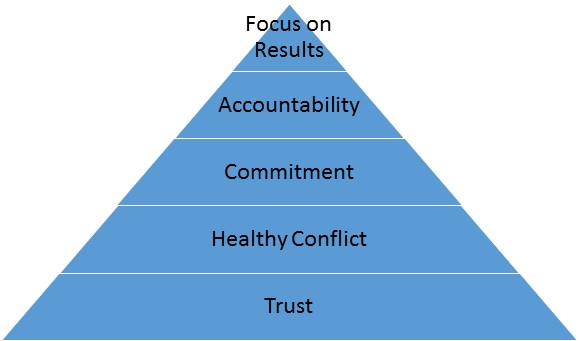In his book The Advantage Patrick Lencioni has written about the importance of having a cohesive leadership team. He says the next competitive advantage for organizations is having a leadership team that is cohesive as measured by 5 critical elements. Having the best strategy, operational efficiencies, strong financials or expert positioning and branding all take a back seat to the importance of the stability, health and cohesiveness of the leadership team.
The five elements are highlighted in the diagram below and summarized further along.
Trust – Evident when leadership team members are completely comfortable being transparent, honest and completely open with one another, where they say and genuinely mean things like, “I screwed up”, “I need help”, “Your idea is better than mine”, etc.
Healthy Conflict – Where the conversation or discussion is focused on all the facts and everybody can weigh in giving their full and complete perspective. Where there is passionate conversation. It is about the issue, not about the personalities. Everything is on the table so the right decision can be made.
Commitment – When a decision is made, everyone can commit to it because they had the opportunity to weigh in. They don’t leave the meeting shaking their head or having side meetings to complain about the decision that was made.
Accountability – It is not the leader who holds the team accountable; it is everyone holding each other accountable for the actions and results that were committed to in the prior step.
Focus on Results – The organization can truly focus on organizational results, not individual results. The allegiance of the team is with the team, not with their individual departments or functional areas. No one takes credit for the results – it is a team effort.
To assess the strength or weakness of these elements, I often work with senior leadership teams taking them through a few simple, yet powerful and insightful exercises to discover where they are at present. I recall working with one senior leadership team recently. A couple of weeks after taking them through this session where much was discovered, I was having my scheduled coaching session with the leader. In my curious way, I asked “Scott” about three of four of the team and how they were doing in specific areas such as, “How is Peter doing with engaging others on the team” or “How is Mary doing with being more responsive to her peers?” Scott was surprised at how I could zero in on the exact struggles he was having in moving the team along the cohesive team model and asked me how I knew these things!
During our coaching session, I was able to help Scott discover some new insights and by deepening his awareness of the dynamics of the team, he was then able to work with each of them in a more focused and targeted manner. Several months later, he noticed measureable improvements in the dynamics, health and cohesiveness of the team, which he currently credits with helping his organization have a record year! This is the power of utilizing a model such as this.
Question: What element would your leadership team most benefit from developing? You can leave your comments below.
Keep watching this space – in a few weeks I will be releasing a new white paper providing key highlights from my newest e-book entitled Success in the C-Suite: Top Seven Strategies for Extraordinary Achievement.

